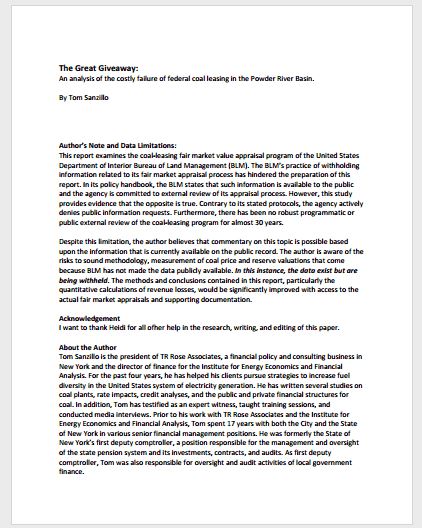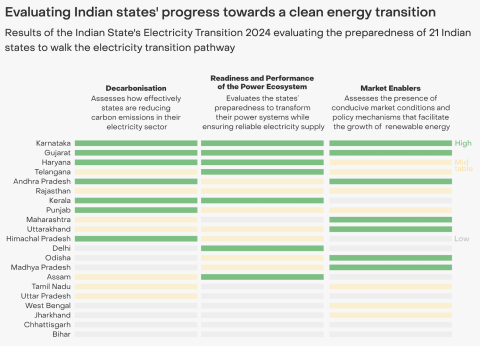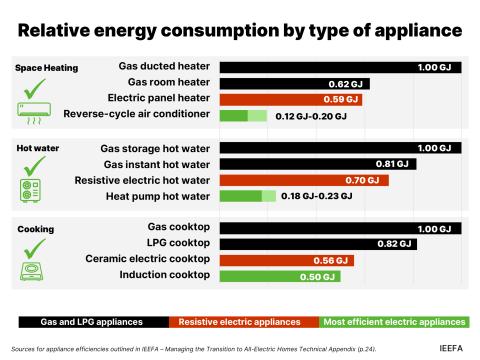IEEFA Report: Almost $30 Billion in Revenues Lost to Taxpayers by ‘Great Giveaway’ of Federally Owned Coal in Powder River Basin

Almost $30 billion in revenues lost to taxpayers by “giveaway” of federally owned coal in Powder River Basin (pdf)
With almost no accountability, BLM failure created boom in electric power industry use of artificially cheap coal from Montana and Wyoming; Next major coal sale set for Thursday
WASHINGTON, D.C. – June 25, 2012 – Taxpayers missed out on an estimated $28.9 billion in revenues over 30 years due to the failure of the federal Bureau of Land Management (BLM) to get fair market value for U.S.-owned coal mined in the Powder River Basin, which currently produces 44 percent of the nation’s coal, according to a major new analysis by the Institute for Energy Economics and Financial Analysis (IEEFA). The report calls for a moratorium on additional Powder River Basin coal sales and a full-scale federal investigation of the deeply flawed BLM program.
A major “red flag” identified in the report: Since 1991, only four out of 26 major Powder River Basin (PRB) coal sales have had more than one bidder, and the small handful that were “competitive” only had two bidders each. IEEFA concludes that this failure resulted from of a lack of transparency under which BLM coal-leasing activities neither have been audited nor subjected to any other publicly available external review for almost 30 years. This lack of oversight is especially troubling as a scandal erupted three decades ago over the same industry give-away practices, and clear, transparent reforms were laid out in the wake of that scandal by Congress.
Issued just days ahead of another major BLM coal sale Thursday (June 28, 2012), the new IEEFA report, titled “The Great Giveaway: An analysis of The United States’ Long-Term Trend of Selling Federally Owned Coal for Less Than Fair Market Value“ is available online at here.
Located in southeastern Montana and northeastern Wyoming, Powder River Basin in the U.S. coal picture has increased significantly in the last 40 years. The Department of Interior (DOI), through its agency the Bureau of Land Management, is responsible for the sale of PRB coal. Given that the United States owns almost all the coal in the region, the U.S. government holds an effective monopoly of western coal. As a result, the DOI is extremely influential, shaping U.S. annual coal production levels and the market price of coal. An example of how the BLM program is not connected to reality, according to the report, is that the Powder River Basin is not officially recognized as a “Coal Production Region,” thus resulting in lower lease prices, and a process where industry proposes land for sale, rather than the government doing so.
IEEFA Executive Director David Schlissel said: “Our new report makes it clear that BLM is failing U.S. taxpayers on a colossal scale. This is a textbook example of what happens when the government operates with almost zero transparency. As a result of policy choices and an inherently subjective and flawed fair market value appraisal process, the U.S. Treasury has lost almost $30 billion in revenue throughout the past 30 years. As applied by the federal government in the case of federal coal leasing, the term ‘fair market value’ rings completely hollow.”
The analysis was conducted by Tom Sanzillo, director of finance for the Institute for Energy Economics and Financial Analysis. The author of several studies on coal plants, rate impacts, credit analyses, and the public and private financial structures for coal, Sanzillo spent 17 years with both the City and the State of New York, serving as the State of New York’s first deputy comptroller, a position responsible for the management and oversight of the state pension system and its investments, contracts, and audits.
Sanzillo said: “The coal boom in electric power generation in America has been fueled by artificially cheap coal from the Powder River Basin. Now, there is the prospect that U.S. taxpayers are effectively subsidizing the expansion of other nations, including China, with underpriced coal that is being exported. Given future mining projections — 12 billion tons by 2035 — it is time for Congress to reevaluate the program. The last meaningful public discussion regarding the agency’s mission and program was nearly 30 years ago. The stakes are much higher now.”
According to the IEEFA report: “The current BLM lease program allows coal producers to set the terms for the mining, distribution, and pricing of coal. Theoretically, the bid process should stimulate competition among coal producers and this competition should then drive up prices to a market level. Competition is meant to both augment the valuation and serve as an independent check on BLM’s coal appraisals. But without competition, the appraisal process is inherently flawed … It is well known among industry officials that the BLM’s common practice is to allow lease applicants to designate coal tracts to inhibit competition. Thus, competition between coal producers in the PRB is virtually nonexistent.”
REPORT RECOMMENDATIONS
| • | The Department of the Interior should implement an immediate moratorium on the sale of federal coal leases in the Powder River Basin. |
| • | The Department of Interior should reinstate the PRB as a Coal Production Region. Redesignating the Powder River Basin and other areas as coal production regions will help the BLM address broader economic issues and set a fairer price to taxpayers. |
| • | Congress must conduct a fundamental review of the federal coal-leasing program, beginning with an evaluation of the use of U.S. coal assets. |
| • | The General Accounting Office should conduct an audit, or series of audits, of the Bureau of Land Management’s federal coal-leasing program. |
| • | The Department of Interior’s Office of the Inspector General should conduct oversight activities regarding the Bureau of Land Management’s interactions with coal producers. |
| • | An independent entity should evaluate the Bureau of Land Management’s coal-leasing program, with specific attention paid to fair market valuation. The entity, which should remain in existence for at least 10 years, should regularly report to the president, Congress, and the public. |
BACKGROUND
In a tightly controlled and mostly secret process, the BLM leases coal tracts to private coal producers. After the BLM and the coal industry select parcels to mine, the agency establishes a fair market price for the coal tract that is held strictly confidential. The parcels are offered at a competitive auction, and the highest bidder that exceeds the confidential price is then awarded the mining lease. Most coal tracts sell for hundreds of millions of dollars and typically generate at least 20 years of revenue for federal and state governments, which split the revenue 50/50. If the BLM fails and sets the price too low, both federal and state governments lose billions of dollars in revenue.
Although the Department of the Interior implemented reforms in the wake of a scandal in the 1980s, neither Congress nor any independent entity has conducted an evaluation of the program in nearly 30 years. The last on-point review that covered the major issues related to fair market value was a 1983 GAO audit.
Recently, Congressman Edward Markey, the ranking Democrat of the House Committee on Natural Resources, requested a GAO review of the federal coal-leasing program. Concerned about the rising levels of exports, the flawed fair market valuation process, and the fact that the program hasn’t been evaluated in 30 years, Markey made the request in order to provide Congress with the most up-to-date and relevant information and analysis on the topic. The GAO has recently agreed to perform the audit despite BLM’s stated belief that the audit is unnecessary.
MEDIA CONTACT: Ailis Aaron Wolf, (703) 276-3265 or [email protected].













